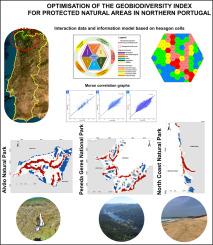葡萄牙北部自然保护区的地理生物多样性指数优化
IF 3.1
2区 地球科学
Q2 GEOGRAPHY, PHYSICAL
引用次数: 0
摘要
大多数关于地质多样性和地质遗产的研究都集中在分析和评价非生物元素上。虽然一些作者强调了非生物元素和生物元素之间的重要联系,但重点大多集中在非生物元素本身,而不是两者之间的相互关系。在这个意义上,我们的建议是在更广泛的意义上分析地质多样性的潜力。换句话说,应该考虑到包括生物多样性在内的所有因素。在“Clictour -葡萄牙北部保护区气候变化弹性旅游”项目的背景下,我们选择了葡萄牙西北部的三个保护区来开展这项工作:Peneda-Gerês国家公园,alv本文章由计算机程序翻译,如有差异,请以英文原文为准。

Optimisation of the geobiodiversity index for protected natural areas in northern Portugal
Most studies on geodiversity and geoheritage have focused exclusively on analyzing and evaluating abiotic elements. Although some authors have emphasized the important links between abiotic and biotic elements, the focus has mostly been on abiotic elements alone and not on the interrelationship between the two. In this sense, our proposal is to analyze the potential of geodiversity in a broader sense. In other words, all elements, including biodiversity, should be considered. In the context of the project ‘Clictour - Resilient Tourism to climate change in protected areas in the north of Portugal’, we selected three protected areas in the northwest of Portugal to carry out this work: the Peneda-Gerês National Park, the Alvão Natural Park and the North Coast Natural Park. Building upon a methodological framework originally developed for the Brazilian Cerrado biome, this study adapts and applies the geobiodiversity index to three protected areas located in northwestern Portugal. The approach enables the identification of spatial patterns and zones of higher relevance by integrating key components of both geodiversity and biodiversity, contributing to a more comprehensive understanding of the natural heritage and conservation value of these landscapes. The methodological procedures were centered on segmenting the study area into hexagonal cells. The parks were subjected to a spatial matrix analysis in GIS and geostatistical environments, capable of articulating the various elements and generating an agglutinating index for each cell. The results reveal the existence of a high index value for geobiodiversity in various areas within the Peneda-Gerês National Park, as well as in the Alvão Natural Park and the North Coast Natural Park. It also shows the importance of integrating the analysis of geodiversity and biodiversity, especially in protected natural areas. This study points to the importance of the hexagonal cell compartmentalization approach, which can provide a multi-level and multi-scale approach to complex spatial analysis studies.
求助全文
通过发布文献求助,成功后即可免费获取论文全文。
去求助
来源期刊

Geomorphology
地学-地球科学综合
CiteScore
8.00
自引率
10.30%
发文量
309
审稿时长
3.4 months
期刊介绍:
Our journal''s scope includes geomorphic themes of: tectonics and regional structure; glacial processes and landforms; fluvial sequences, Quaternary environmental change and dating; fluvial processes and landforms; mass movement, slopes and periglacial processes; hillslopes and soil erosion; weathering, karst and soils; aeolian processes and landforms, coastal dunes and arid environments; coastal and marine processes, estuaries and lakes; modelling, theoretical and quantitative geomorphology; DEM, GIS and remote sensing methods and applications; hazards, applied and planetary geomorphology; and volcanics.
 求助内容:
求助内容: 应助结果提醒方式:
应助结果提醒方式:


